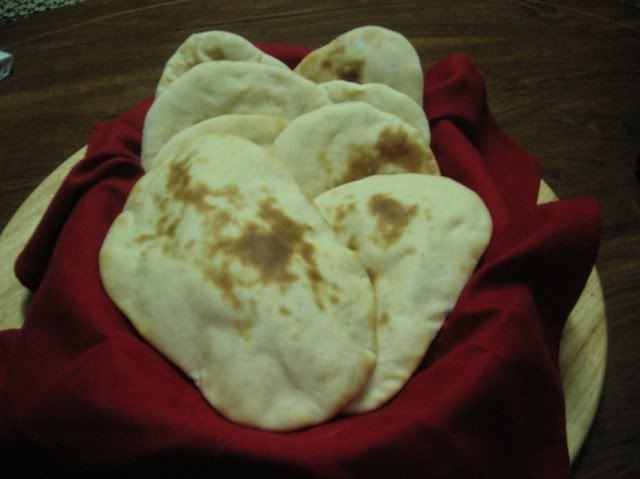
The meaning of it all.
Lately I've been thinking a lot about what this site is for. Part of the reason I've been thinking about this is my recent employment at Mercy Corps, but the disputes the last few days have brought to my attention that we don't all come here with the same expectations about what this site is trying to do. So let me riff a little about what I think think The Fresh Loaf is about. I'll admit up front, I'm not entirely certain either, and as the site has grown my feelings may have changed and probably will continue to do so. Still, some reflection is worthwhile, and hopefully it'll help explain why some things set me off.
The site is a little over two years old. In that time we've had people come and go, but a decent number of regulars have hung around. Many of them (as well as new members) have commented that they don't tend to post to online communities but that this one is different. People here are more helpful, more courteous, less judgmental, more humane than on most other boards.
As the site grows, I'm coming to realize that *that* is what I want to cultivate here. More than the recipes, more than the photos, more than anything else it is the kindness and the humanity that I want to see flourish. Given the choice between this become the most authoritative bread baking site online but run by a bunch of a**holes or a site full of compassionate, caring, but perhaps mediocre bakers, I will hands down choose the latter. That said, I think we have some very talented bakers here and the site content keeps getting better and better. I don't think kindness needs be thrown aside to achieve greatness.
Mercy Corps' motto, which I see and think about every day, is a quote from Gandhi: "Be The Change." In our every day interactions with one another, we can make the world a better place. I honestly think what we've been doing here is consistent with that mission. Every time a baker on one side of the world helps a baker on the other side of the world regardless of borders, race, or religion, we make the world a better place. Every time someone who has been wanting to try to bake something but has been too intimidated to finally tries it because we gave them the confidence to and it brings joy to them and their loved ones, we make the world a better place. Every time we post a tip or a hint we are focusing on our common humanity by sharing our passions with one another rather than focus on our differences and by doing so, in a small way, we are making the world a better place.
As I've mentioned, I worked with Peter Reinhart and the other Brother Juniper's bakers while in high school. I watched how they took something as simple as neighborhood cafe and used it to bring kindness, joy, inspiration, love, and caring into people's lives. They did things far nobler that anything I've done here, such as provide food for the terminally ill and employ a number of people with handicaps that made it difficult for them to find work elsewhere. Their model has inspired me to think about the mission of this site as something more than just exchanging recipes.
I'm continuing to think about how we can use this site to be an agent for positive change in the world, both on micro-level ("offer encouragement to excited new bakers") to the macro-level ("could we do a World Bread Day fundraiser for people who can't even afford to put bread on the table?"). I think we can do more with it.
All that said, I am grateful to the people on this site who come here each day and share their talents and experience. By doing so they enrich my life and the lives of many others.






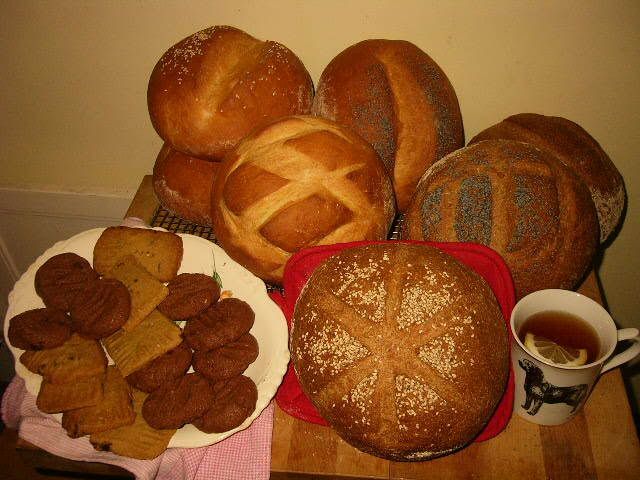 Loaves and puppies have this in common, that more is invariably better, so long as you find good homes for them all. An attribute that doesn't hold for everything- mice and snakes are best in sedate groupings of no more than two or three, for example, and I suspect that even bunnies have their tipping point. (Nah, prob'ly not...) I had the remarkable good fortune to find myself handing out bread to nearly a dozen people this weekend. Since any home-baked bread is generally enough to inspire gratitude, I kept it straightforward with a basic all-white loaf and a 100% whole wheat. The wheat worked a treat (God I love that phrase.) The person it was earmarked for is of that rare breed who prefers his bread only a very little removed from the wheat field. I hybridized from recipes in Beth Hensperger's Bread Bible and King Arthur's 200th Anniversary Cookbook, and the dictates of what was in the cupboard. I added a quantity of cooked cracked wheat so as not to be accused of being wimpy, yet the crumb was so, well, edible, that I might've fallen short...oh, the cookies are a couple varieties of shortbread, and now watch carefully as I insult an entire people, I needed cookies of a British heritage, and when I searched for recipes what did I find but shortbread, ginger-nut biscuits, and something alluringly referred to as digestive biscuits...
Loaves and puppies have this in common, that more is invariably better, so long as you find good homes for them all. An attribute that doesn't hold for everything- mice and snakes are best in sedate groupings of no more than two or three, for example, and I suspect that even bunnies have their tipping point. (Nah, prob'ly not...) I had the remarkable good fortune to find myself handing out bread to nearly a dozen people this weekend. Since any home-baked bread is generally enough to inspire gratitude, I kept it straightforward with a basic all-white loaf and a 100% whole wheat. The wheat worked a treat (God I love that phrase.) The person it was earmarked for is of that rare breed who prefers his bread only a very little removed from the wheat field. I hybridized from recipes in Beth Hensperger's Bread Bible and King Arthur's 200th Anniversary Cookbook, and the dictates of what was in the cupboard. I added a quantity of cooked cracked wheat so as not to be accused of being wimpy, yet the crumb was so, well, edible, that I might've fallen short...oh, the cookies are a couple varieties of shortbread, and now watch carefully as I insult an entire people, I needed cookies of a British heritage, and when I searched for recipes what did I find but shortbread, ginger-nut biscuits, and something alluringly referred to as digestive biscuits... 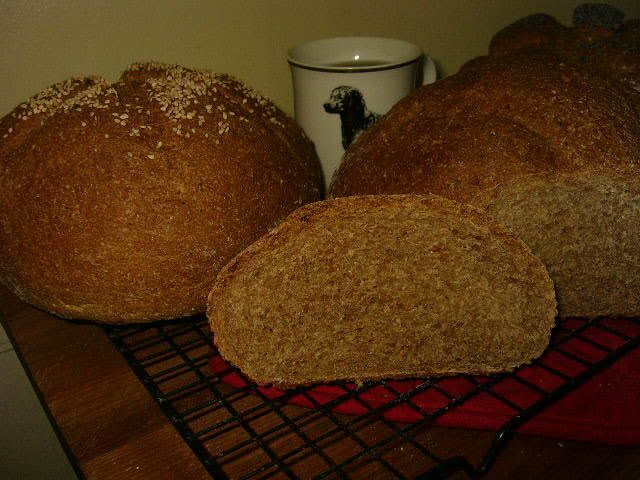
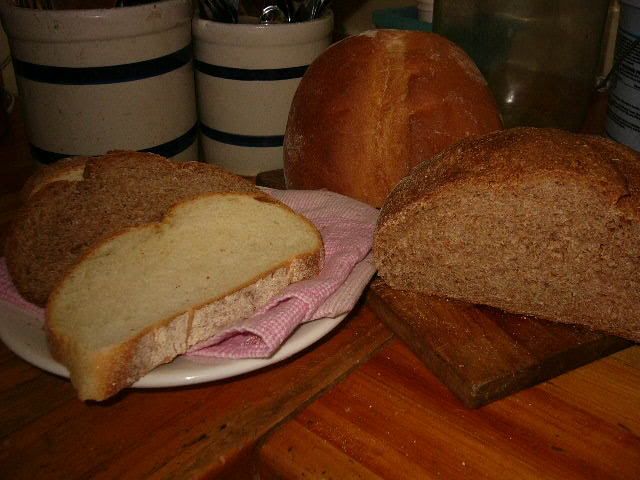
 PAIN RUSTIQUE: PAIN RUSTIQUE: Today I made Hamelman's Pain Rustique and I'm very happy with it. It is creamy and delicious. Thanks TTonka and Susan. I made 3 loaves, one for my neighbor, one in a bread tin for my grandaughter (brushed with butter) and one for us. I will make this again for sure. I'm also going to finally buy Hamelman's book so I don't have to struggle to read the recipe from a pdf. By the way Susan my icons to enlarge the page go off when I go into the file. Who knows why.
PAIN RUSTIQUE: PAIN RUSTIQUE: Today I made Hamelman's Pain Rustique and I'm very happy with it. It is creamy and delicious. Thanks TTonka and Susan. I made 3 loaves, one for my neighbor, one in a bread tin for my grandaughter (brushed with butter) and one for us. I will make this again for sure. I'm also going to finally buy Hamelman's book so I don't have to struggle to read the recipe from a pdf. By the way Susan my icons to enlarge the page go off when I go into the file. Who knows why. 

 Today I
Today I received a sample package from Filbert foods of T-55 flour they had created for import. It smelled about the same as my Harvest King and KA AP flour but had a slightly darker color than the King Arthur. I couldn't detect any smell that would distinguish it from the others.
received a sample package from Filbert foods of T-55 flour they had created for import. It smelled about the same as my Harvest King and KA AP flour but had a slightly darker color than the King Arthur. I couldn't detect any smell that would distinguish it from the others.
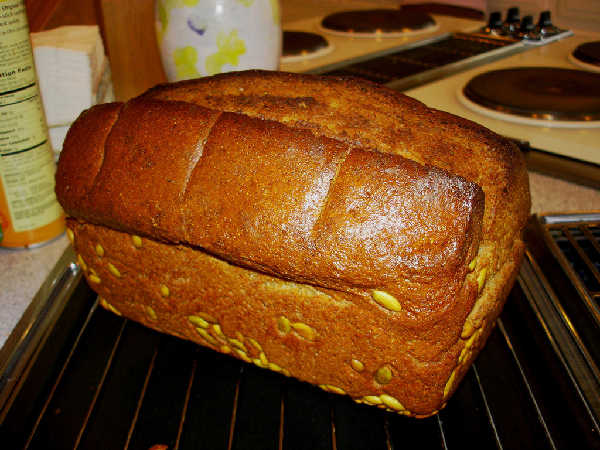 Marcel's Grandmother's Spelt Bread (1)
Marcel's Grandmother's Spelt Bread (1)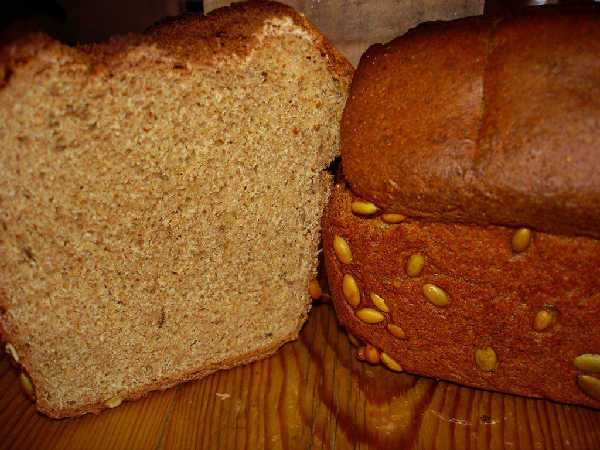 Marcel's Grandmother's Spelt Bread (2)
Marcel's Grandmother's Spelt Bread (2)


